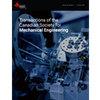基于仿生结构的数控机床工作台多目标优化设计
IF 0.8
4区 工程技术
Q4 ENGINEERING, MECHANICAL
Transactions of The Canadian Society for Mechanical Engineering
Pub Date : 2024-04-16
DOI:10.1139/tcsme-2023-0214
引用次数: 0
摘要
为了提高数控机床工作台的静态和动态性能,提出了一种基于仿生结构的多目标优化设计方法,包括以仿生学为基础,为原有的 XK5032 机床设计了四种仿生结构工作台,分别是竹截面仿生结构工作台、蜘蛛网仿生结构工作台、蜂窝仿生结构工作台和燎原仿生结构工作台。采用有限元模拟方法对原始仿生结构工作台和四种仿生结构工作台进行了静态和模态分析,并通过模态实验进行了验证。结果表明,与原始桌子相比,四种仿生桌子的整体力学性能都有所提高。利用熵权 TOPSIS 方法,从四种仿生桌中选出了燎原仿生结构桌。对燎原仿生结构表进行多目标优化设计,得到三个优化候选方案。再次使用熵权 TOPSIS 法从这三个方案中选择最优解,结果与原始台模相比,质量降低了 0.8%,一阶固有频率提高了 2.8%,最大位移降低了 3.2%,最大等效应力显著降低了 21.6%。本文章由计算机程序翻译,如有差异,请以英文原文为准。
Multi-objective optimization design for the table of a CNC machine tool based on bionic structures
In order to improve the static and dynamic performance of CNC machine tool tables, a multi-objective optimization design method based on bionic structures is proposed, which involves. Based on the bionics, four types of bionic structure tables for the original XK5032 machine tool were designed, namely bamboo cross-section bionic structure table, spider web bionic structure table, honeycomb bionic structure table, and prairie rushes bionic structure table. Static and modal analysis of the original and four types of bionic tables were conducted using finite element simulation methods validated through modal experiments. The results show that the overall mechanics of the four bionic tables have been improved compared to the original table. Using the entropy weight TOPSIS method, the prairie rushes bionic structure table was selected from four types of bionic tables. Conducting multi-objective optimization design on the prairie rushes bionic structure table, three optimization candidate schemes were obtained. The entropy-weighted TOPSIS method was used again to select the optimal solution from these three schemes, resulting in a 0.8% reduction in mass, an increase in first-order natural frequency by 2.8%, a decrease in maximum displacement by 3.2%, and a significant 21.6% reduction in maximum equivalent stress compared to the original table.
求助全文
通过发布文献求助,成功后即可免费获取论文全文。
去求助
来源期刊
CiteScore
2.30
自引率
0.00%
发文量
53
审稿时长
5 months
期刊介绍:
Published since 1972, Transactions of the Canadian Society for Mechanical Engineering is a quarterly journal that publishes comprehensive research articles and notes in the broad field of mechanical engineering. New advances in energy systems, biomechanics, engineering analysis and design, environmental engineering, materials technology, advanced manufacturing, mechatronics, MEMS, nanotechnology, thermo-fluids engineering, and transportation systems are featured.

 求助内容:
求助内容: 应助结果提醒方式:
应助结果提醒方式:


